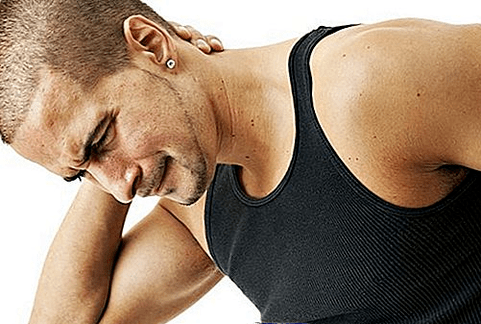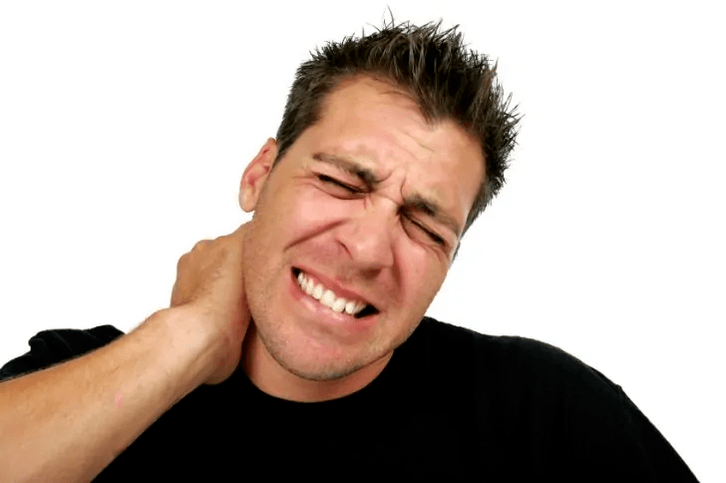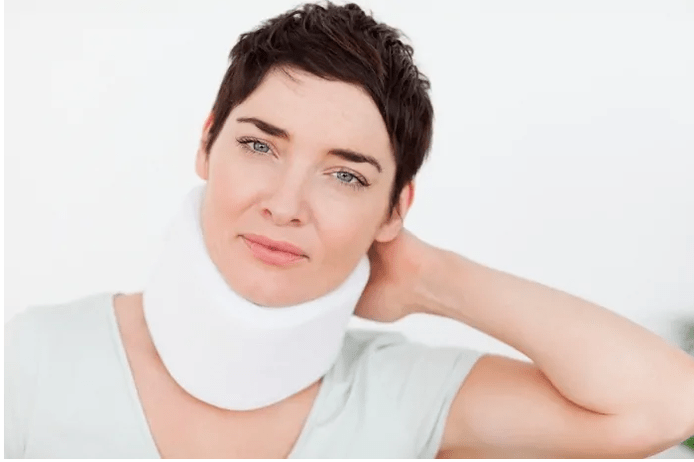Osteochondrosis is most often observed in the cervical spine, which is due to the anatomical features of the structures of this department. Firstly, the cervical vertebrae are located very tightly to each other. And secondly, the muscle frame of the neck is poorly developed. It is for these reasons that the cervical vertebrae and compression of nerve roots, blood vessels are so easilyThe lower cervical vertebrae are more often affected than the upper ones.

Cimptoms of cervical osteochondrosis
Clinical symptoms of cervical osteochondrosis are extremely diverse. Many people do not even suggest all kinds of symptoms (pain in their hands, dizziness, etc. ), can be associated with the pathology of the neck. In general, all the symptoms that occur with cervical osteochondrosis can be considered within three syndromes:
- Compression-brown syndromes;
- Irritative-reflex syndromes;
- Vail artery syndrome.
Compression-crust syndromes
Against the background of cervical osteochondrosis, intervertebral hernias, as well as osteophytes, can be formed. These structures compress the nerve roots, which leads to the occurrence of radiculitis symptoms. The compression of each spine is associated with specific reflex, motor, sensitive disorders:
- When compressing the spine of C1, pain occurs, as well as impaired sensitivity (decrease in sensitivity, numbness, tingling skin, sensation of goosebumps) in the parietal area;
- When compressing the spine of C2, pain develops, as well as a change in sensitivity in the parietal-and-consuming area of the head;
- When compressing the spine of C3, pain is noted, as well as a change in sensitivity in the neck. In addition, a person may be disturbed by the feeling of swelling of the tongue on the one hand, difficulty movements of the language, and speech impairment.
- When compressing the s4 spine, pains are noted, as well as a change in sensitivity in the clavicle. Icote, dysphony may occur. Since fibers of the diaphragmatic nerve pass in the spine, with compression of the spine, breathing, pain in the heart may occur.
- When compressing the spine of C5, pain in the shoulder develop, as well as a change in the skin sensitivity on the outer surface of the shoulder.
- When compressing the span of C6, the pain spreads from the neck to the shoulder blade, as well as the outer surface of the shoulder, the forearm and to the thumb of the brush. A violation of skin sensitivity in this area is noted. The two -headed muscle is exaggerated, the reflex is reduced.
- When compressing the spine of C7, the pain from the neck spreads under the shoulder blade, to the outer surface of the shoulder, the forearm and to the II -II fingers of the hand. A violation of skin sensitivity in this area is noted. The three -headed muscle is exaggerated, the reflex is reduced.
- When compressing the spine of C8, the pain from the neck spreads on the hand to the little finger. The skin sensitivity in this area is disturbed. Hypotrophy and a decrease in the reflex from the three -headed muscle occur.
For radicular syndrome, acute pain and its strengthening when moving the head are characteristic.
Irritate-reflex syndromes
The early stages of osteochondrosis are characterized by the occurrence of reflex syndromes. With cervical osteochondrosis, the following options for reflex syndromes may occur:
- Cervicalgia is an intensive aching pain in the neck, which is as expressed as much as possible after waking up in the morning, as well as when turning the head, cough and even laughter.
- Cervicobrachialgia - pain focuses in the neck and nape.
- Cervicobrachialgia - pain in the neck, shoulder and forearm.
A cervicobrachalgia can occur with muscle-tonic, vegetative-vascular and Neurodystrophic manifestations. Muscle tonic syndromes are the result of reflex muscle spasm. The following muscle-tonic syndromes are distinguished:
- Syndrome of the lower oblique muscle - is manifested by constant aching pain in the neck and the back of the head on one side, which significantly intensifies during the turns of the head;
- Shovel-reflective syndrome-manifests itself with aching pain in the neck and upper corner of the scapula and in the shoulder or even the side surface of the chest. A characteristic feature is an increase in pain during the pronation of the brush opened by the lower back.
Neurodystrophic syndromes include shoulder-packed periarthrosis, epicondyles shoulder, shoulder-ward syndrome. Shoulder -shoulder periarthrosis - characterized by pain in the shoulder joint, intensifying during the movements of the shoulder or raising the hand up. The pain can radiate to the arm, neck. The skin in the shoulder joint is swollen. For the syndrome of the shoulder, the presence of signs of a spatular Periartroz in a combination with vegetative-vascular, trophic changes in the wrist joint and brush is characteristic. The skin of the brush becomes edematous, its color changes, the local temperature rises. Epicondyles shoulder is a neurodystrophic change in the shoulder rod, in the place of attachment of many muscles. It is manifested by aching, constant pains in the area of the rod, intensifying in the implementation of abrupt movements at the elbow or brush.

Vail artery syndrome
The vertebral artery takes place in the channel formed by the processes of the cervical vertebrae. The vessel provides the blood supply to many brain structures. The narrowing of the vessel is possible both due to its reflex spasm and mechanical compression. When narrowing the vessel, the syndrome of the vertebral artery is formed, which are characterized by the following symptoms:
- Cranially: aching, constant headache more often one -sided, noticeably intensifying with head movements. The pain spreads from the back of the forehead.
- Soreness of the scalp, determined with light touch even when combing hair.
- KOHLEOVESTILARNYI Violations: are manifested by dizziness, tinnitus (ringing in the ears), a decrease in a light degree, and a violation of balance.
- Visual disorders: darkening, flickering flies before my eyes.
- Neurasthenic syndrome: irritability, emotional lability, sleep disturbance.
- Vegetative symptoms: heat, chills, cooling of the hands.
- Fluctuations in blood pressure.
- With the compression of the vertebral artery caused by a sharp turn of the head, a person can lose consciousness. This option is also possible: a person falls as if primed, but at the same time is conscious. Such a violation is called drop attacks.
Treatment of cervical osteochondrosis
It is very difficult to fight osteochondrosis in an advanced form. Various medicines are used to eliminate the symptoms of the disease. A no less significant role is played by therapeutic gymnastics, as well as physiotherapy, massage. In some cases, wearing a special collar is very useful. Folk remedies will help supplement the treatment.
Wearing a cervical collar
Wearing a collar helps to relieve muscle tension from the neck, and also gives the correct position to the spine, thereby eliminating compression of the vertebral artery and nerve roots. The cervical collars are stiff (Shantsa collar), as well as inflatable. Shanz collar is a dense frame that is fastened on the neck. He assumes all the severity of his head, thereby relaxing the tense muscles of the neck. Inflatable collars are a device that needs to be put on the neck, and then with the help of an attached pear, pump air. The inflated collar pulls the spine. The collar is not worn all day, but a few hours a day. On average, the length of wearing the device is a month. Please note: the need to use the collar is determined by the doctor. In no case do not put it on your own without a doctor’s prescription. In some cases, the collar can impede the vessels and nerves, which can provoke serious consequences.
Exercises for cervical osteochondrosis

Therapeutic gymnastics is recommended for all patients with osteochondrosis in the absence of contraindications. The performance of physical exercises during exacerbations of the disease is contraindicated. Therapeutic gymnastics can be done after the pain subsides. Regular performance of exercises allows you to strengthen the muscle frame, as well as reduce the load on the intervertebral discs. Regular physical activity contributes to the improvement of blood supply in the neck and as a result of normalizing metabolic processes occurring in the intervertebral discs. An approximate set of exercises for cervical osteochondrosis:
- Sit on a chair. Turn your head on the right and left.
- Tilt your head down, touching the chest seizure.
- Pull your neck back, while drawing a chin.
- Put your palm on your forehead and press it, while it is important to tilt your head forward, resisting.
- The palm must alternately need to be applied to the temples and absolutely like in the previous exercise to put the resistance to the movement of the head with a hand.
- Raise your shoulders as much as possible, count to ten. Then lower your shoulders and relax. After ten seconds, do the same manipulation.
All exercises must be repeated ten times.

























